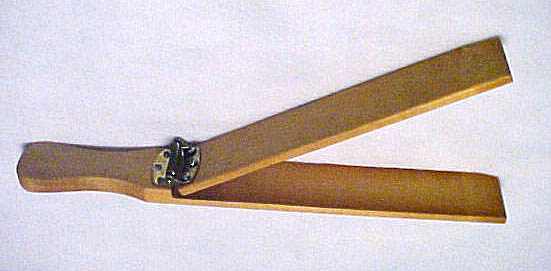slapstick
[English]
HISTORY: A percussion instrument that creates a loud clapping or slapping sound, often called a whip. This instrument has been used in the theatre for hundreds of years and can be traced back as far as the theatre performances of Plautus in the 3rd century BCE. Through the years, the slapstick has been used extensively to add extra comic effect for sight gags in theatre, vaudeville, and in cartoons. It is seen occasionally in classical music, such as the 6th Symphony of Gustav Mahler and is used as the sound of whips in a number of light classical and more contemporary compositions.
PHYSICAL DESCRIPTION: The slapstick is a simple instrument that consists of two flat pieces of wood, hinged at one end, which, when struck together produce a slapping sound.
SOUND PROPERTIES: The sound of the slapstick is a sharp crack, slap or whipping sound that can be performed loud or soft. The size of the slapstick (and strength and composition of material to some degree) provides the quality of the sound. A larger instrument can produce a louder and slightly lower pitched cracking sound.
RANGE: The slapstick has no way of altering or adjusting accurate pitches, so there is no range, nor is there any specific pitch or set of pitches associated with the instrument. It is used solely for rhythmic reinforcement and effect.


